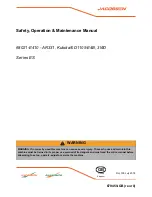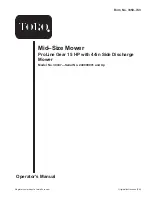
25
ig. 72
1
2
16.6
Maintenance of electrical installation
FUSES
The electrical system is protected by fuses which, if interrupted, will
cause the entire electrical system to fail. There are two main 40 A fuses:
one protects the entire electrical system (ig.73/C) and the other pro
-
tects the radiator fan (ig.73/D). Under the seat, to the left of the opera
-
tor, other fuses are installed to protect the components of the electrical
system (ig.74). If electrical problems persist after the fuses have been
replaced, contact the authorised service centre. Never attempt to carry
out major repairs without having the necessary means and technical
expertise.
IMPORTANT
: you must not replace fuses with fuses of a dif-
ferent rating than that indicated in the manual and on the relevant
decal.
ig. 73
ig. 74
C
D
MICROSWITCH FOR GRASS-CATCHER POSITION
•
A safety microswitch detects whether the basket is in the working
position (Fig. 75). Otherwise the PTO will not engage. The micros-
witch is located next to the load chute, to the left of the operator.
•
ig. 75
ENGINE TEMPERATURE SENSOR
A sensor that detects the temperature of the coolant is located on the
engine head. When the temperature of the coolant exceeds 95°C, the
sensor sends a signal to the ECU located under the dashboard (ig. 76)
that triggers the automatic cleaning cycle of the radiator, reversing the
direction of rotation of the fan for a few seconds, cleaning the ins.
If the coolant exceeds 105°C, an acoustic alarm is activated and at the
same time the warning light on the dashboard tums on (ig. 77). The
blades are automatically disengaged.
If the coolant exceeds 110°C, the engine is switched off.
If the sensor is faulty or absent, it will not be possible to start the engine
and the control unit will signal the sensor failure by activating a continu-
ous acoustic alarm.
ig. 76
ig. 77
RELAY
• There are four radiator fan control relays (ig. 78) located on the
side of the radiator to the left of the operator.
•
There are four engine supply relays (key, glow plugs, starter mo-
tor, diesel pump) (Fig. 79), located on the opposite side to the right
of the operator.
ig. 78
ig. 79
NEUTRAL POSITION MICROSWITCH
The travel pedal is connected to a microswitch located behind the
hydraulic pump (ig. 80) which signals the clutch’s neutral position.
ig. 80
PARKING BRAKE MICROSWITCH
The parking brake lever activates a microswitch (ig. 81) that signals
that the brake is engaged and allows the engine to remain running
even if the operator leaves the driver’s seat.








































